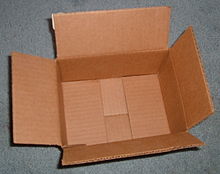Cardboard box

Cardboard boxes are industrially prefabricated boxes, which are primarily used for packaging goods and materials. "Cardboard box" is misnomer, as what most people know as cardboard boxes are actually made of corrugated fiberboard, not cardboard.
Cardboard boxes can be recycled to produce paper, or given a post-primary life as a cheap material for the construction of a range of projects, among them being science experiments, children's toys, costumes and insulative lining.
Living in a cardboard box is stereotypically associated with homelessness.[1] However, in 2005 Melbourne architect Peter Ryan designed a house composed largely of cardboard.[2]
History
The first commercial cardboard box was produced in England in 1817[3] by Sir Malcolm Thornhill[4]. The first cardboard box manufactured in the United States was made in 1895.[5] By 1900, wooden crates and boxes were being replaced by corrugated paper shipping cartons. The advent of flaked cereals increased the use of cardboard boxes. The first to use cardboard boxes as cereal cartons were the Kellogg brothers.
This section needs expansion. You can help by adding to it. |
Cardboard box manufacture in France
The Musée du Cartonnage et de l'Imprimerie (Museum of the Cardboard Box) in Valréas, France traces the history of cardboard box making in the region.[6] Cardboard boxes have been used there since 1840 for transporting the Bombyx mori moth and its eggs from Japan to Europe by silk manufacturers, and for more than a century the manufacture of cardboard boxes was a major industry in the area.[citation needed]
Cardboard boxes and children
Eartheasy recommends[7] "the simple, basic, unglamorous, glorious cardboard box" as a present for young children, citing as its merits the fact that it doesn't matter if it breaks or wears out.
A common cliché is that, if presented with a large and expensive new toy, a child will quickly become bored with the toy and play with the box instead. Although this is usually said somewhat jokingly, children certainly enjoy playing with boxes, using their imagination to portray the box as an infinite variety of objects. One example of this from popular culture is Calvin of the Calvin and Hobbes comic strip, who often used a cardboard box for imaginative purposes from a "transmogrifier" to a time machine.
So prevalent is the cardboard box's reputation as a plaything that in 2005 a cardboard box was added to the National Toy Hall of Fame, one of very few non-brand-specific toys to be honoured with inclusion. As a result, a toy "house" (actually a log cabin) made from a large cardboard box was added to the Hall, housed at the Strong - National Museum of Play in Rochester, New York.
References
- ^ Stratton-Coulter, Danielle (2005-04-20). "When a cardboard box is 'home'". The Daily Iowan.
{{cite news}}: Check date values in:|date=(help) - ^ O'Brien, Kerrie (2005-06-08). "Out of the box". The Age.
{{cite news}}: Check date values in:|date=(help) - ^ Paula Hook and Joe E. Heimlich. "Paper and paper products". A History of Packaging. Retrieved 2005-10-26.
- ^ "The Ohio Journal of Science". 1915 v.88 1988.
{{cite news}}:|first=missing|last=(help); Check date values in:|date=(help); line feed character in|first=at position 16 (help) - ^ "Corrugated cardboard - packaging that has been used for almost 150 years". Farusa Packaging. Retrieved 2005-10-26.
- ^ Geary, James (2000-10-13). "Thinking Inside the Box: Discover the wonderful world of cardboard at the Museum of the Cardboard Box". Time (magazine).
{{cite news}}: Check date values in:|date=(help) - ^ "Tips for Sustainable Giving". Eartheasy. Retrieved 2005-10-26.
Further reading
- "What to do with a cardboard carton". Journey to Forever. Retrieved 2005-10-26. — more uses for cardboard boxes, including uses as an oven, composter, armchair, and house
- Amanda Formaro. "Cardboard Box Costumes". Thrifty Fun. Retrieved 2005-10-26. — several Halloween costumes that can be made with cardboard boxes and paint
- Lauren Guerriero. "What Can You Do With a Plain Old Cardboard Box?". Parents.com. Retrieved 2005-10-26. — six projects using cardboard boxes as children's playthings
- "How To Package Your Product For Shipping". PackagingPrice.com. Retrieved 2006-04-27. — A guide detailing how best to package items that need to be shipped. Includes technical information about using cardboard (corrugated) boxes.
See also
- The Adventure of the Cardboard Box (a Sherlock Holmes story)
- Cardboard Box (Metal Gear) The humorous use of a cardboard inside the Metal Gear Saga.
